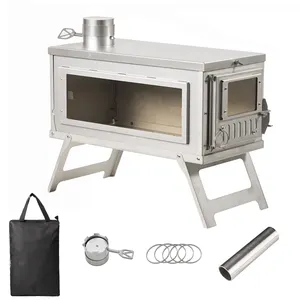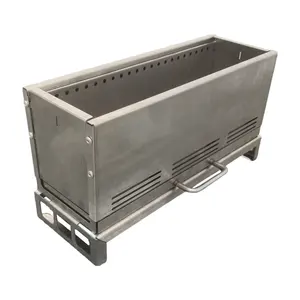The camping portable wood stove stands as an essential apparatus for outdoor enthusiasts. It marries the elemental charm of a campfire with the utility of a cookstove, proving itself as an invaluable companion for wilderness excursions. Its clever design epitomizes the resourcefulness of human innovation, turning the rudimentary task of wood burning into a manageable, adaptable source of heat that is both transportable and effective.
Types and Characteristics of Camping Wood Stoves
Delving into the array, the camping wood stove market presents a variety of models. Ultralight stoves are tailored for the individual trekker, emphasizing minimal weight and compactness. Conversely, larger, sturdier stoves are designed for group outings, offering an expanded cooking surface and extended burning duration. Some stoves boast a flat top for convenient pot placement, while others feature a grated top, perfect for direct grilling. Multi-fuel stoves, capable of utilizing wood, solid fuel tablets, or alcohol, afford versatility in fuel selection. Each stove's design considers the equilibrium among weight, durability, and thermal output, ensuring a suitable option for every camping situation.
Structure and Operation of Portable Wood Stoves
The portable wood burning stove is an exemplar of engineering, often adopting a cylindrical or box-shaped combustion chamber that optimizes thermal efficiency while reducing spatial demands. Airflow is paramount, with intake valves or dampers granting users the ability to modulate oxygen supply and thereby control flame intensity. The flue or chimney, an integral element, is engineered to be tall enough to channel smoke away yet can be dismantled for ease of transport. Certain models incorporate a baffle to enhance combustion efficacy and thermal distribution, a boon for culinary activities in the great outdoors.
Materials and Properties
In terms of materials, stainless steel is a favored choice for camping wood heaters owing to its resistance to corrosion and reasonable heft. More sophisticated models might employ carbon steel, which boasts a higher carbon concentration, yielding enhanced durability and thermal resilience. Titanium variants represent the zenith of portable stoves, offering an unparalleled strength-to-weight ratio, albeit at a premium price. The material selection directly influences the stove's longevity, heat retention, and overall performance under the rigors of outdoor conditions.
Business Usages and Applications
Within the commercial sphere, portable wood stoves extend beyond mere camping utilities. They serve outdoor educators in imparting survival techniques, forest rangers in secluded cabins, and humanitarian organizations providing vital cooking resources in areas afflicted by disaster. In the hospitality industry, they enrich the rustic appeal of eco-lodges and outdoor retreats. The stoves' independence from fossil fuels renders them a valuable asset for enterprises prioritizing sustainability and autonomy.
Functions and Tasks
The camping wood burning heater fulfills a dual purpose. Primarily, it offers a dependable heat source, crucial for comfort and warmth in the wild. As a culinary apparatus, it accommodates various cookware for boiling or meal preparation, and with an added grill, it is suitable for barbecuing. Certain stoves are even equipped with a flat surface for baking or frying, rendering them a multifaceted tool for any outdoor cooking requirement.
Features and Unique Selling Points
Notable attributes of a portable log burner stove include its straightforward assembly and disassembly, the efficiency of its combustion, and the scant smoke emitted. Distinctive selling points may encompass a stove's integrated cookware support system, its collapsibility into a flat pack, or the presence of a viewing window to observe the flame and enhance the ambiance. These characteristics are meticulously crafted to elevate the user experience and distinguish the product in a competitive marketplace.
Benefits and Positive Outcomes
The portable wood furnace confers numerous advantages. It diminishes reliance on gas canisters, which is both cost-efficient and eco-conscious. The heat it generates is typically more intense and focused than that of an open campfire, delivering warmth more effectively. For those in search of seclusion, the stove's contained flame is less likely to draw unwelcome attention in the wilderness. The psychological comfort provided by a hot meal and the capability to warm a shelter are also significant.
How to Use a Camping Portable Wood Stove
Proper utilization of a portable wood burning stoves camping setup commences with choosing an appropriate location—flat, shielded from the wind, and distant from combustible materials. Igniting the fire necessitates kindling and patience, with larger wood pieces added once the fire is steady. Flame regulation is achieved through the air vents, and constant supervision of the stove is imperative during operation. Post-cooking, allowing the stove to cool and disposing of the ashes responsibly ensures readiness for subsequent use.
How to Choose the Right Camping Portable Wood Stove
Opting for the correct portable camping stove wood model entails assessing the intended use context. For harsh, elevated terrains, a stove with a sturdy windscreen and robust construction is vital. For more casual campers, priorities may lie in ease of use and rapid deployment. The fuel source is another factor; a wood-only stove suffices if timber is abundant, but in areas where it is scarce, a multi-fuel stove may be more pragmatic.
How to Clean and Maintain Your Portable Wood Stove
Upkeep of a portable camping wood burner is straightforward yet essential. Routine cleansing post-use averts soot and residue accumulation, which can impede functionality. Inspecting for signs of corrosion or wear, especially at joints and welds, can forestall malfunctions on subsequent excursions. Replacing deteriorated gaskets and seals is crucial to maintain the stove's efficiency and safety.
How to Install a Camping Wood Heater
Setting up a tent wood heater must always prioritize safety. It is imperative to ensure the tent fabric is at a secure distance from the flue and that the stove is stable. Employing a heat shield or fireproof mat can offer extra protection. Additionally, proper venting of the flue to the exterior is crucial to prevent smoke or carbon monoxide accumulation within the tent.
Alibaba.com curates a selection of camping portable wood stoves tailored to the diverse requirements of the adventurous. Each stove is conceived with the user's safety, efficiency, and environmental considerations in mind, providing a means to savor the outdoors with the comfort and warmth of a controlled blaze. Whether for personal enjoyment or as a component of a commercial offering, these stoves are poised to elevate any outdoor experience.











































 浙公网安备 33010002000092号
浙公网安备 33010002000092号 浙B2-20120091-4
浙B2-20120091-4